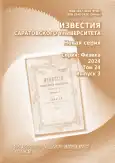Arachidonic acid metabolites and cortical depression: From local to spatial model
- Authors: Verisokin A.Y.1, Verveyko D.V.1, Brazhe A.R.2
-
Affiliations:
- Kursk State University
- Lomonosov Moscow State University
- Issue: Vol 24, No 3 (2024)
- Pages: 250-261
- Section: Biophysics and Medical Physics
- URL: https://journals.rcsi.science/1817-3020/article/view/265416
- DOI: https://doi.org/10.18500/1817-3020-2024-24-3-250-261
- EDN: https://elibrary.ru/PIILVU
- ID: 265416
Cite item
Full Text
Abstract
About the authors
Andrey Yu. Verisokin
Kursk State University
ORCID iD: 0000-0002-3655-7682
33 Radishcheva St., Kursk 35000, Russia
Darya V. Verveyko
Kursk State University
ORCID iD: 0000-0003-3661-3928
33 Radishcheva St., Kursk 35000, Russia
Alexey R. Brazhe
Lomonosov Moscow State University
ORCID iD: 0000-0002-1495-4652
Scopus Author ID: 9242162600
ResearcherId: G-9635-2016
119991, Russian Federation, Moscow, Leninskie gory, 1
References
- Koehler R. C., Gebremedhin D., Harder D. R. Role of astrocytes in cerebrovascular regulation // J. Appl. Physiol. 2006. Vol. 100. P. 307–317. https://doi.org/10.1152/japplphysiol.00938.2005
- Attwell D., Buchan A., Charpak S., Lauritzen M., MacVicar B. A., Newman E. Glial and neuronal control of brain blood flow // Nature. 2010. Vol. 468. P. 232–243. https://doi.org/10.1038/nature09613
- Zhenzhou L., McConnell H. L., Stackhouse T. L., Pike M. M., Zhang W., Mishra A. Increased 20-HETE signaling suppresses capillary neurovascular coupling after ischemic stroke in regions beyond the infarct // Front. Cell. Neurosci. 2021. Vol. 15. Article number 762843. https://doi.org/10.3389/fncel.2021.762843
- Gómez-Ramos A., Díaz-Nido J., Smith M. A., Perry G., Avila J. Effect of the lipid peroxidation product acrolein on tau phosphorylation in neural cells // J. Neurosci. Res. 2003. Vol. 71. P. 863–870. https://doi.org/10.1002/jnr.10525
- González A., Singh S. K., Churruca M., Maccioni R. B. Alzheimer’s Disease and Tau Self-Assembly: In the Search of the Missing Link // Int. J. Mol. Sci. 2022. Vol. 23, iss. 8. Article number 4192. https://doi.org/ijms23084192
- Yamazaki K., Vo-Ho V.-K., Bulsara D., Le N. Spiking Neural Networks and Their Applications: A Review // Brain Sciences. 2022. Vol. 12, iss. 7. Article number 863. https://doi.org/10.3390/brainsci12070863
- Manninen T., Havela R., Linne M. L. Computational Models for Calcium-Mediated Astrocyte Functions // Front. Comput. Neurosci. 2018. Vol. 12. Article number 14. https://doi.org/10.3389/fncom.2018.00014
- Huneau C., Benali H., Chabriat H. Investigating Human Neurovascular Coupling Using Functional Neuroimaging: A Critical Review of Dynamic Models // Front. Neurosci. 2015. Vol. 9. Article number 467. https://doi.org/10.3389/fnins.2015.00467
- Постнов Д. Э., Постнов Д. Д., Жирин Р. А. Саратовский национальный исследовательский государственный университет имени Н. Г. Чернышевского. Моделирование колебательных и волновых процессов в двумерных средах произвольной геометрии на базе высокоскоростных параллельных вычислений на графических процессорных устройствах по технологии CUDA «AGEOM_CUDA». Свидетельство о государственной регистрации программы для ЭВМ № 2012610085 РФ от 10.01.2012.
- Ullah G., Jung P., Cornell-Bell A. H. Anti-phase calcium oscillations in astrocytes via inositol (1, 4, 5)-trisphosphate regeneration // Cell Calcium. 2006. Vol. 39. P. 197–208. https://doi.org/10.1016/j.ceca.2005.10.009
- Verisokin A. Yu., Verveyko D. V., Postnov D. E., Brazhe A. R. Modeling of astrocyte networks: Towards realistic topology and dynamics // Front. Cell. Neurosci. 2021. Vol. 15. Article number 645068. https://doi.org/10.3389/fncel.2021.645068
- Chizhov A. V., Zefirov A. V., Amakhin D. V., Smirnova E. Y., Zaitsev A. V. Minimal model of interictal and ictal discharges “Epileptor-2” // PLoS Comput. Biol. 2018. Vol. 14. Article number e1006186. https://doi.org/10.1371/journal.pcbi.1006186
- Cressman J. R., Ullah G., Ziburkus J., Schiff S. J., Barreto E. The influence of sodium and potassium dynamics on excitability, seizures, and the stability of persistent states: I. Single neuron dynamics // J. Comput. Neurosci. 2009. Vol. 26, iss. 2. P. 159–170. https://doi.org/10.1007/s10827-008-0132-4
- MacVicar B. A., Newman E. A. Astrocyte regulation of blood flow in the brain // Cold Spring Harb. Perspect. Biol. 2015. Vol. 7. Article number a020388. https://doi.org/10.1101/cshperspect.a020388
- Volterra A., Liaudet N., Savtchouk I. Astrocyte Ca2+ signalling: An unexpected complexity // Nat. Rev. Neurosci. 2014. Vol. 15. P. 327–335. https://doi.org/10.1038/nrn3725
- Khakh B., Sofroniew M. Diversity of astrocyte functions and phenotypes in neural circuits // Nat. Neurosci. 2015. Vol. 18. P. 942–952. https://doi.org/10.1038/nn.4043
- Verkhratsky A., Nedergaard M. Physiology of Astroglia // Physiol. Rev. 2018. Vol. 98. P. 239–389. https://doi.org/10.1152/physrev.00042.2016
Supplementary files









